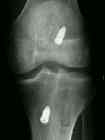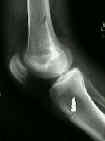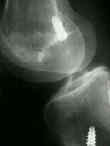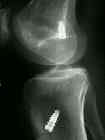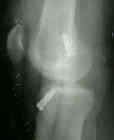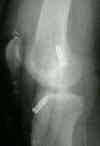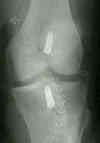- because the slope of the intercondylar notch will vary from 26 to 44 deg, the tibial tunnel should be accordingly positioned between the anterior third and the midpoint of the saggital length of the tibia;
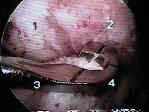
- referenced off the PCL:
- this reference assumes that the PCL is normal;
- graft is positioned on tibia so that it does not impinge on roof of outlet of intercondylar notch when the knee is fully extended;
- guide wire should end up 7 mm anterior to the PCL;
- if a 10 mm tunnel is made (drill w/ 5 mm radius) then there should be 2 mm of space between the ACL and the PCL;
- tunnel placement is incorrect if the reconstructed ACL bends around the PCL;
- in the report by Hutchinson MR and Bae TS (2001), the authors evaluated the reproducibility of landmarks used for accurate anatomic
placement of the tibial tunnel in ACL reconstruction;
- evaluated medial tibial eminence, PCL, "over-back" position, true posterior border of tibia, and posterior border of lateral meniscus.
- 42 pairs of cadaveric knees were dissected, and anatomic measurements were made regarding the ACL insertion and these various landmarks;
- measurements based on the medial tibial eminence and posterior border of the meniscus were particularly erratic;
- most reproducible anatomic landmark was the posterior cruciate ligament;
- anterior border of PCL was consistently 6.7 mm posterior to post border of ACL and 10.9 mm posterior to central sagittal insertion point of ACL;
- ref: Reproducibility of anatomic tibial landmarks for anterior cruciate ligament reconstructions.
- referenced off the medial tibial spine:
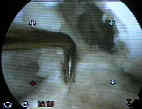
- an alterantive entry point is located slightly anterior to the peak of the media tibial eminence along its inner face;
- hence, reaming the tibial tunnel will "blow out" the inner 1/3 of the tibial eminence;
- referenced off of the lateral meniscus:
- entry site is at the level of the posterior aspect of the anterior horn of lateral meniscus;
- referenced off the intercondylar roof:
- center of the tibial tunnel is placed 4-5 mm posterior to anterior edge of intercondylar roof, w/ the knee in hyper-extension;
- some authors question whether the intercondylar roof should be used to position the tibial footprint;
- ref:
- referenced off of the ACL:
- center of the tibial tunnel is referenced off of the posterior half of the ACL foot print;
- traditional teaching has emphasized the need to completely debride the ACL stump inorder to avoid potential arthrofibrosis;
- report by Day (1996): emphasizes preserving the stump of the ACL, both to help guide proper graft insertion point and to preserve
neurological and vascular elements in the remaining graft;
- Revision Anterior Cruciate Ligament (ACL) reconstruction after failed Bone Patella Tendon Bone Reconstruction (BPTB). Day B. Arthroscopy.1996;12(3):381-382.
- Editorial Overview.
- Posterior tibial tunnel placement to avoid anterior cruciate ligament graft impingement by the intercondylar roof. An in vitro and in vivo study.
- pitfalls:
- tibial tunnel needs to be placed posterior to the roof of the intercondylar notch inorder to avoid impingement on the reconstructed graft;
- should be slightly postero-medial to center of normal ACL attachment;
- if ligament is too lateral it will rub against the lateral edge of intercondylar notch;
- if placed too anteriorly, the graft may limit flexion (due to the cam effect of the femoral condyles) and may limit extension (due to impingement);
- Complications:
- 25-year-old male who required ACL revision because the tibial tunnel was placed too far posterior;
- the result of this tunnel placement was a knee that had a grossly positive Lachman and Pivot shift;
- 22-year-old male who underwent bone patellar bone reconstruction for ACL tear;
- the tibial tunnel has been placed slightly more anteriorly than is recommended, but there was no apparent detrimental consequences;
- the knee was stable and there was no evidence of impingement
Recreating an acceptable angle of the tibial tunnel in the coronal plane in anterior cruciate ligament reconstruction using external landmarks.
Effect of Femoral Socket Position on Graft Impingement After Anterior Cruciate Ligament Reconstruction


